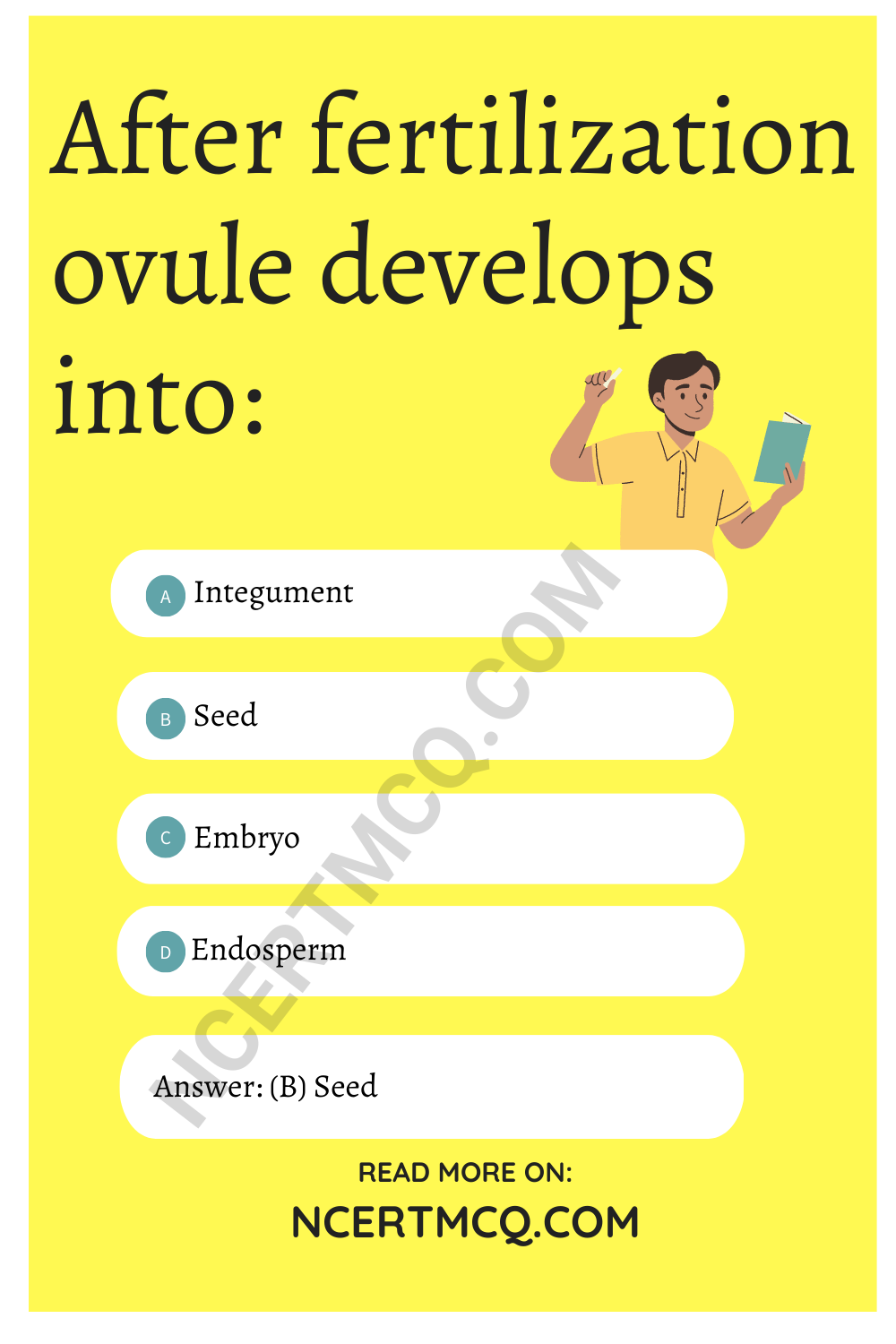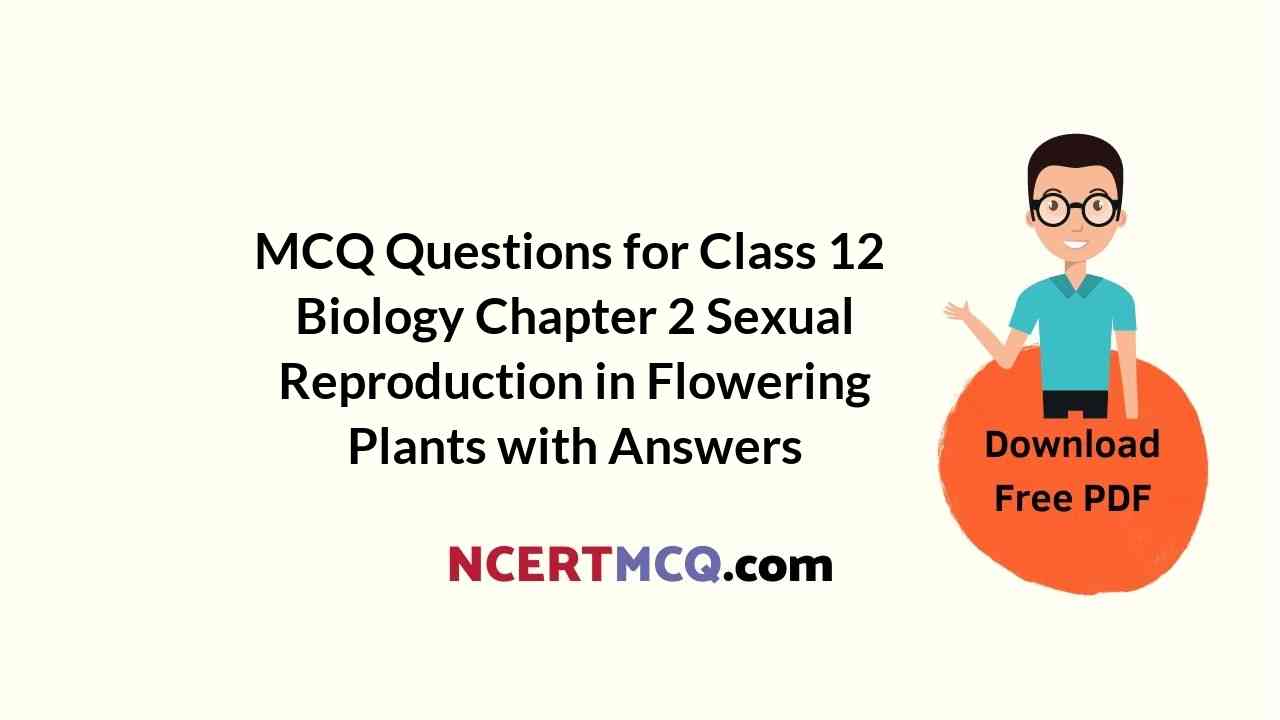Check the below NCERT MCQ Questions for Class 12 Biology Chapter 2 Sexual Reproduction in Flowering Plants with Answers Pdf free download. MCQ Questions for Class 12 Biology with Answers were prepared based on the latest exam pattern. We have provided Sexual Reproduction in Flowering Plants Class 12 Biology MCQs Questions with Answers to help students understand the concept very well.
Class 12 Biology Chapter 2 MCQ With Answers
Biology Class 12 Chapter 2 MCQs On Sexual Reproduction in Flowering Plants
Class 12 Biology Chapter 2 MCQ Question 1.
Pollination in Lotus is:
(a) By water
(b) By wind
(c) By insect
(d) All of these
Answer
Answer: (a) By water
Sexual Reproduction In Flowering Plants MCQ Question 2.
Haploid plants develop by pollen are called ……..
(a) Emasculation
(b) Parthenocarpy
(c) androgenesis
(d) somatic hybridization
Answer
Answer: (d) somatic hybridization
Sexual Reproduction In Flowering Plants Class 12 MCQ Question 3.
Closed flower:
(a) Decliny
(b) Cteistogamy
(c) Dichogamy
(d) None of these
Answer
Answer: (b) Cteistogamy
MCQ Of Chapter 2 Biology Class 12 Question 4.
Demerit of self pollinatlon is:
(a) Unisexua
(b) Dichoganty
(c) Hetorostyle
(d) None of these
Answer
Answer: (b) Dichoganty
Chapter 2 Biology Class 12 MCQ Question 5.
Which structure is not found in Angiosperm?
(a) Archegonium
(b) Carpel
(c) Anther
(d) Magagametophyte
Answer
Answer: (a) Archegonium
Chapter 2 Biology Class 12 MCQs Question 6.
Normal Embryosac of Angiosperm is :
(a) Unicellular
(b) Bicelled
(c) Penta celled
(d) Seven called
Answer
Answer: (a) Unicellular
Biology Class 12 Chapter 2 MCQs Question 7.
Commonly in a mature fertilized ovule n, 2n, 3n conditions are respectively found in :
(a) Endosperm, nucellus and egg
(b) Egg. antipodals and endosperm
(c) Integuments, synergids and egg
(d) Egg, nucellus and endosperm
Answer
Answer: (d) Egg, nucellus and endosperm
Biology Chapter 2 Class 12 MCQs Question 8.
After fertilization ovule develops into:
(a) Integument
(b) Seed
(c) Embryo
(d) Endosperm
Answer
Answer: (b) Seed

Chapter 2 Class 12 Biology MCQ Question 9.
Parthenogenesis is common in :
(a) Grape
(b) Mango
(c) Citrus
(d) Litchi
Answer
Answer: (a) Grape
Class 12 Chapter 2 Biology MCQ Question 10.
An orthrotropous ovule is one in which micropyle and chalaza are :
(a) Oblique to funiculus
(b) At right angles to funiculus
(c) In straight line with funiculus
(d) Parallel to funiculus
Answer
Answer: (c) In straight line with funiculus
Chapter 2 Bio Class 12 MCQ Question 11.
In an ovule meiotic takes place in:
(a) Nucellus
(b) Megaspore mother cell
(c) Megaspore
(d) Archesporium
Answer
Answer: (b) Megaspore mother cell
Biology Class 12 Chapter 2 MCQ Question 12.
In Capsella the endosperm in generally:
(a) Haploid
(b) Diploid
(c) Triploid
(d) Tetraploid
Answer
Answer: (c) Triploid
MCQ Biology Class 12 Chapter 2 Question 13.
All of the following structures are found in angiosperms except ?
(a) Archegonium
(b) Pistil
(c) Anther
(d) Megagametophyte
Answer
Answer: (a) Archegonium
Class 12th Biology Chapter 2 MCQ Question 14.
Totipotency is
(a) Development of a fruit from a flower in a medium
(b) Development of an organ from a cell in a medium
(c) Development of tissues of all kinds from a cell in a medium
(d) Development of tissues of all kinds from a cell in a medium
Answer
Answer: (c) Development of tissues of all kinds from a cell in a medium
Class 12 Biology Ch 2 MCQ Question 15.
Who proved that the cells are totipotent?
(a) White
(b) Skoog
(c) Miller
(d) Steward
Answer
Answer: (d) Steward
Question 16.
A typical angiospermic embryo sac is usually:
(a) One-celled
(b) Two-celled
(c) Five-celled
(d) seven-celled
Answer
Answer: (d) seven-celled
Question 17.
Fatheroflndian Angiosperm Embnology is:
(a) B. M. John
(b) B. G L. Swami
(c) R.N. Kapil
(d) P. Maheshwari
Answer
Answer: (d) P. Maheshwari
Question 18.
If cotyledons are brought above the soil the germination is:
(a) Hypogeal
(b) Epigeal
(c) Vivipaiy
(d) None of these
Answer
Answer: (b) Epigeal
Question 19.
Polymbryony occurs in:
(a) Maize
(b) Citrus
(c) Corchorus
(d) Carthamus
Answer
Answer: (b) Citrus
Question 20.
In Monocots, grafting is almost impossible because they lack :
(a) Cambium
(b) Ground tissue
(c) Vascular bundle
(d) Parenchymatous cells
Answer
Answer: (a) Cambium
Question 21.
Double fertilization in angiosperms was discovered by:
(a) Strassburger
(b) J. C. Bose
(c) Maheshwari
(d) Nawaschin
Answer
Answer: (d) Nawaschin
Question 22.
How many meiotic divisions are necessary to produce 100 pollen grains ?
(a) 100
(b) 50
(c) 25
(d) 20
Answer
Answer: (c) 25
Question 23.
Double fertilization means:
(a) Fusion of two eggs
(b) Fusion of egg and pollen nuder of two pollen grains
(c) Fusion of two polar nuclei with one male gamete
(d) Fusion between synergid cells and male gamete
Answer
Answer: (c) Fusion of two polar nuclei with one male gamete
Question 24.
Pollination by bats is called:
(a) omithophily
(b) Entromophily
(c) Cheiropterophily
(d) Hydrophily
Answer
Answer: (a) omithophily
Question 25.
Pollination by snails is called:
(a) Malecophily
(b) Zoophily
(c) Anemophily
(d) Hydrophily
Answer
Answer: (a) Malecophily
Question 26.
Development of fruit without fertilizations is:
(a) Parthenogenesis
(b) Heterostyly
(c) Parthenocarpy
(d) Agamospermy
Answer
Answer: (c) Parthenocarpy
Question 27.
Who discovered fertilization?
(a) Nawaschin
(b) Strassburger
(c) Leeuwen Hock
(d) Robert Hook
Answer
Answer: (b) Strassburger
Question 28.
When more than one embryoper embryosac is found. It is called:
(a) Embryogeny
(b) Amphimisis
(c) Agamospormy
(d) Polyembryoni
Answer
Answer: (d) Polyembryoni
Question 29.
When pollen tube enter into the nucellus through micropyle is called:
(a) Porogamy
(b) Xenogamy
(c) Mesogamy
(d) Dikogamy
Answer
Answer: (a) Porogamy

Question 30.
Maturation of male and female sex organs at different times is known as:
(a) Herkogamy
(b) Dichogamy
(c) Polygamy
(d) Apogamy
Answer
Answer: (a) Herkogamy
Question 31.
Stalk of ovule is called :
(a) Funicle
(b) Caruncle
(c) Nucellus
(d) Pedicel
Answer
Answer: (a) Funicle
We hope the given NCERT MCQ Questions for Class 12 Biology Chapter 2 Sexual Reproduction in Flowering Plants with Answers Pdf free download will help you. If you have any queries regarding Sexual Reproduction in Flowering Plants CBSE Class 12 Biology MCQs Multiple Choice Questions with Answers, drop a comment below and we will get back to you soon.
Class 12 Biology MCQ:
- Reproduction in Organisms Class 12 MCQ
- Sexual Reproduction in Flowering Plants Class 12 MCQ
- Human Reproduction Class 12 MCQ
- Reproductive Health Class 12 MCQ
- Principles of Inheritance and Variation Class 12 MCQ
- Molecular Basis of Inheritance Class 12 MCQ
- Evolution Class 12 MCQ
- Human Health and Disease Class 12 MCQ
- Strategies for Enhancement in Food Production Class 12 MCQ
- Microbes in Human Welfare Class 12 MCQ
- Biotechnology: Principles and Processes Class 12 MCQ
- Biotechnology and its Applications Class 12 MCQ
- Organisms and Populations Class 12 MCQ
- Ecosystem Class 12 MCQ
- Environmental Issues Class 12 MCQ
